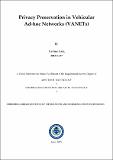Please use this identifier to cite or link to this item:
http://drsr.daiict.ac.in//handle/123456789/568Full metadata record
| DC Field | Value | Language |
|---|---|---|
| dc.contributor.advisor | Das, Manik Lal | |
| dc.contributor.author | Garg, Garima | |
| dc.date.accessioned | 2017-06-10T14:43:24Z | - |
| dc.date.available | 2017-06-10T14:43:24Z | - |
| dc.date.issued | 2015 | |
| dc.identifier.citation | Garg, Garima (2015). Privacy preservation in vehicular ad-hoc networks (VANETs). Dhirubhai Ambani Institute of Information and Communication Technology, vi, 33 p. (Acc.No: T00531) | |
| dc.identifier.uri | http://drsr.daiict.ac.in/handle/123456789/568 | - |
| dc.description.abstract | Vehicular Ad-hoc Networks (VANETs) are the special application of Mobile Ad-hoc Networks (MANETs). Due to increase in the number of road accidents, VANETs provide security to road traffic by sending safety messages to other vehicles. However, the safety messages provide safety from accidents, the privacy of the vehicles from adversaries is also a concern. Vehicles have to preserve the privacy of contextual information like identity of the vehicle, location of the vehicle, speed of the vehicle and route etc. Therefore, the privacy preservation of vehicle is important because by using the vehicle’s information an adversary can easily send false information to other vehicles which can cause a road accident. One of the methods to preserve privacy in VANETs is by using Pseudonym Identities (PIDs). PIDs are not real IDs of the vehicles. PIDs are different from Real Identities (RID) of vehicles. We have suggested an approach for privacy preservation in VANETs using PIDs and Certificate-Less SignCryption (CLSC) [16] scheme as cryptographic primitive. This approach is more secure over hash-chain based and certificate-based schemes. We have also simulated a hash-chain based scheme which is better than hash-chain based scheme described in [7]. However, the scheme has many limitations therefore we moved on to certificate-less based schemes after reviewing the certificate-based scheme’s limitations. The proposed scheme uses CLSC as cryptographic primitive and there are two more system components other than the vehicle, RSU and CA. The VANET system is divided into zones and each zone has a ZRSU which provide credentials to the vehicle and when a vehicle moves from its home zone to other zone handover is done. Vehicles contact to PKGC in handover phase. PKGC is situated at the separation point of two zones. The Proposed approach is secure and efficient. It provides privacy for vehicles. | |
| dc.publisher | Dhirubhai Ambani Institute of Information and Communication Technology | |
| dc.subject | Vehicular Ad-hoc networks | |
| dc.subject | Wireless security | |
| dc.subject | Mobile computing | |
| dc.subject | Wireless communication systems | |
| dc.classification.ddc | 388.312 GAR | |
| dc.title | Privacy preservation in vehicular ad-hoc networks (VANETs) | |
| dc.type | Dissertation | |
| dcterms.subject | certificate-less signcryption | |
| dcterms.subject | hash-chain based | |
| dcterms.subject | certificate-based | |
| dcterms.subject | pseudonym identity | |
| dcterms.subject | ZRSU | |
| dcterms.subject | PKGC | |
| dc.degree | M. Tech | |
| dc.student.id | 201311037 | |
| dc.accession.number | T00531 | |
| Appears in Collections: | M Tech Dissertations | |
Files in This Item:
| File | Description | Size | Format | |
|---|---|---|---|---|
| 201311037.pdf Restricted Access | 1.38 MB | Adobe PDF |  View/Open Request a copy |
Items in DSpace are protected by copyright, with all rights reserved, unless otherwise indicated.
